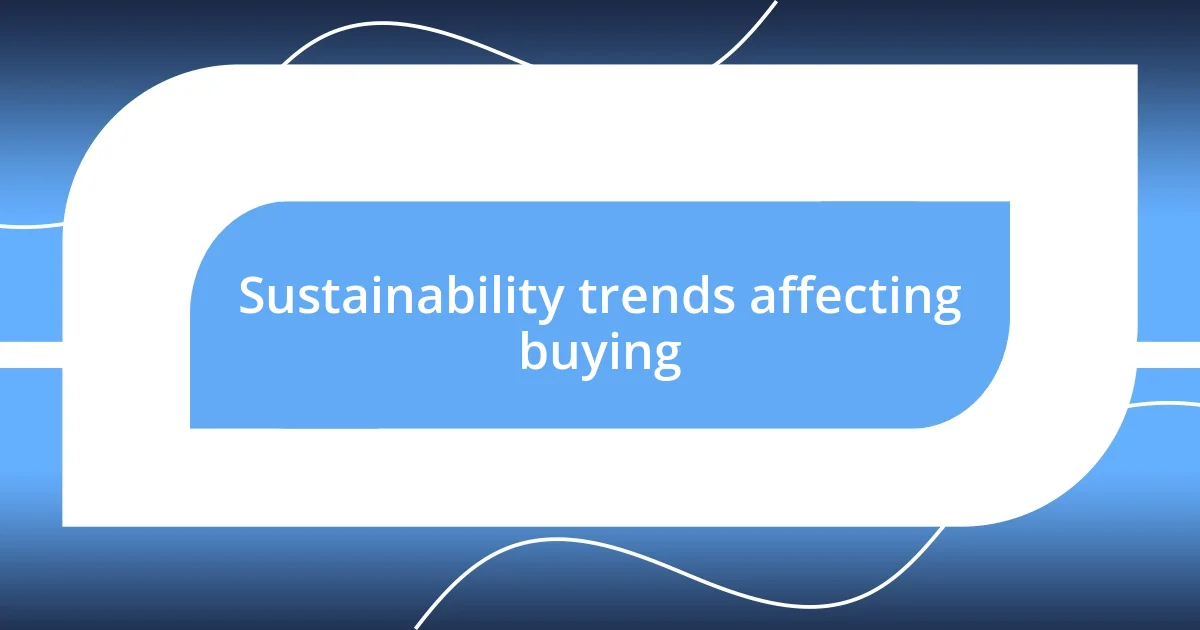Key takeaways:
- The rise of personalized shopping experiences enhances customer journeys, making it pivotal for brands to understand consumer preferences through algorithms.
- Sustainability is increasingly influencing consumer purchasing decisions, with shoppers gravitating towards brands that demonstrate eco-friendly practices and values.
- Future trends in e-commerce will be driven by advancements in artificial intelligence, augmented reality, and social commerce, significantly transforming how consumers interact with brands and make purchases.

E-commerce trends overview
E-commerce has evolved at a staggering pace in recent years. I remember first stepping into the world of online shopping and being fascinated by the sheer convenience it offered. Fast forward to today, I can’t help but wonder, how many of us can truly say we’ve shopped exclusively in physical stores in the past year?
One of the most significant trends I’ve noticed is the rise of personalized shopping experiences. It’s remarkable how algorithms can now predict what we might want before we even know it ourselves. Have you ever found yourself scrolling through an online store, only to see an item that feels like it was handpicked for you? That’s the power of personalization, and it really enhances the shopping journey.
Another trend that stands out to me is the growing importance of sustainability in e-commerce. I’ve seen brands pop up that don’t just market products but promote a lifestyle centered around eco-friendliness. It makes me think, how much are we willing to change our purchasing habits when we feel a genuine connection to a brand’s values? This emotional investment can drive loyalty in ways that traditional marketing simply can’t match.

Importance of staying updated
Staying updated in the e-commerce landscape is crucial for anyone looking to thrive. I can’t tell you how often I’ve seen brands that lag behind on trends struggling to connect with their audience. It’s like watching a movie with no sound; you miss the nuances that keep viewers engaged. Understanding the newest trends not only helps in adapting strategies but also opens up fresh opportunities for growth.
- Consumer Expectations: They change rapidly, and if your brand isn’t keeping up, you risk losing customer interest.
- Technological Advancements: Embracing new tools can enhance efficiency and improve customer experiences significantly.
- Competitive Edge: Knowing what’s trending allows you to stay ahead of rivals who may not be as informed.
- Brand Loyalty: When customers see you adapt to their needs, they’re more likely to stick around and champion your brand.
I once revamped my approach based on emerging trends, focusing more on mobile shopping interfaces and seamless checkout processes. The shift dramatically increased customer satisfaction and sales volume. It’s like my business was reborn overnight; I learned that being in the know can act as a lifeline in times of uncertainty.

Key trends shaping e-commerce
E-commerce is constantly evolving, and one trend that speaks to me is the integration of social commerce. As I scroll through social media, I often find myself discovering products I didn’t even know I needed. This blending of social platforms and online shopping creates a seamless experience that feels organic and engaging. It’s fascinating how companies leverage social proof—when I see a friend’s recommendation or a trending product, it nudges me closer to making a purchase.
Another noteworthy trend is subscription services. I recall trying out a subscription box for gourmet snacks last year, and it transformed my snacking routine entirely. It’s more than just convenience; it’s the excitement of receiving a curated package each month that keeps me engaged. The way these services customize offerings based on my preferences resonates deeply with my desire for personalization in shopping experiences.
The shift toward augmented reality (AR) is something I find particularly intriguing. Imagine being able to visualize how a piece of furniture would look in your home before buying it. When I experimented with a mobile app that allowed me to place virtual items in my space, it felt revolutionary. It bridges the gap between the online and physical shopping experience, making it easier for customers to make informed decisions.
| Trend | Description |
|---|---|
| Personalized Shopping | Using algorithms to tailor product recommendations to users’ preferences. |
| Social Commerce | Leveraging social media platforms for shopping, enhancing product discovery. |
| Subscription Services | Offering curated products on a recurring basis, fostering customer engagement. |
| Augmented Reality | Allowing customers to visualize products in their space before purchase. |
| Sustainability | Promoting eco-friendly practices and values, strengthening customer loyalty. |

Impact of mobile shopping
The rise of mobile shopping has completely transformed how we buy products. I remember a time when I would wait until I got home to browse my favorite online stores. Now, the freedom to shop anytime and anywhere really resonates with me. Have you ever found yourself making a purchase while waiting in line or simply lounging on your couch? The convenience of mobile shopping is undeniable, and it creates an impulsive buying culture that brands can’t ignore.
Moreover, the ability to access a plethora of options right from my phone makes me feel empowered as a consumer. I often find myself comparing products and prices on the go. This instant access shapes my buying behavior—sometimes for the better. I recall a situation where I was hesitant about buying a running watch, but with just a few taps on my phone, I could read reviews and see what others thought. It gave me the confidence to make that purchase almost instantly. Don’t you love when you can make informed decisions in seconds?
I also believe that the mobile shopping experience hinges on how personalized it feels. Last summer, I was browsing for summer clothes and was pleasantly surprised when my favorite app recommended pieces based on my past purchases. It felt like it knew me! This kind of tailored experience not only enhances customer satisfaction but also builds loyalty. I often wonder, does your shopping app recognize your style? When you shop this way, it feels less like a chore and more like a curated experience, and that makes all the difference.

Personalization in e-commerce
The power of personalization in e-commerce truly astounds me. I once browsed an online bookstore, and after just a few clicks, the website suggested titles that aligned perfectly with my reading history. It felt as if the store was genuinely speaking to my interests, creating a unique shopping journey. Have you ever experienced that delightful surprise of finding a suggested item that you didn’t know you wanted? It’s a compelling reminder that understanding customers at a deeper level can significantly enhance their shopping experience.
I also remember a shopping spree during the holiday season when I was overwhelmed by choices. To my relief, my favorite fashion retailer had a section just for me. Their algorithm wisely curated items in line with my previous purchases. The moment I spotted a tailored coat that seemed to leap off the screen just for me, I couldn’t help but feel understood. This sort of tailored experience genuinely fosters a deeper connection between the brand and the consumer. How special does it feel when a brand seems to know you?
Moreover, it’s incredible how personalization extends beyond mere suggestions. I recently signed up for a beauty subscription box, and the thrill of receiving products tailored to my skin type and preferences made me a loyal customer. Each product felt curated, as though a friend had handpicked it for me. This kind of attention to detail not only elevates the excitement of unboxing but also builds trust and loyalty over time. Doesn’t it feel good when a brand invests time in understanding who you are? That emotional connection can transform casual shoppers into devoted fans.

Sustainability trends affecting buying
Sustainability is becoming a pivotal factor in my purchasing decisions. I often find myself researching brands that prioritize eco-friendly practices. Recently, I was about to buy a trendy shirt when I stumbled upon a company that used sustainable materials and guaranteed fair labor. That moment made me pause and reflect—do my purchases align with my values? It’s amazing how a little background on a brand can sway me toward a more thoughtful choice.
I can’t help but share an experience I had with a packaging-focused initiative. When I ordered a pair of shoes online, I was pleasantly surprised to see them arrive in a beautifully minimal box made from recycled materials. Not only did it feel good to know my purchase was environmentally friendly, but it also made me appreciate the brand’s commitment to sustainability. Have you ever felt a sense of satisfaction from supporting a brand that cares about the planet as much as you do? It’s a connection that goes beyond the product itself.
As I navigate through my shopping experiences, I’ve noticed that my friends and I often gravitate towards brands that tell a sustainability story. I recently organized a small reunion, and I was amazed by how our conversations centered around eco-conscious brands we discovered. The shared excitement about purchasing from companies that emphasize responsible sourcing and production truly bonded us. Isn’t it fascinating how our choices can connect us, transforming solitary shopping into a collective movement towards a more sustainable future?

Future predictions for e-commerce
Looking ahead, I can confidently say that artificial intelligence will continue to reshape the e-commerce landscape. Just the other day, I read about a startup utilizing AI chatbots for customer service. Can you imagine getting instant answers from a friendly chatbot while you shop? It’s a game-changer for improving customer satisfaction and speeding up response times, making me curious about how this technology will evolve.
Moreover, the rise of augmented reality (AR) is something I find particularly exciting. I recently tried using an AR app to visualize furniture in my living room before making a purchase. The ability to see how a product fits into my own space was incredibly satisfying. I can’t help but wonder how many more brands will adopt such technology to bridge the gap between online and offline shopping experiences.
As we move forward, I believe social commerce will gain even more traction. I can recall scrolling through my Instagram feed and stumbling upon a video of a friend unboxing a subscription box from a trendy skincare brand. The enthusiasm was contagious! It made me realize how social media can play a pivotal role in influencing purchasing decisions. Aren’t we all looking for that next trusted recommendation from our networks? It’s thrilling to think about how e-commerce will continue to intertwine with our social lives in the future.












